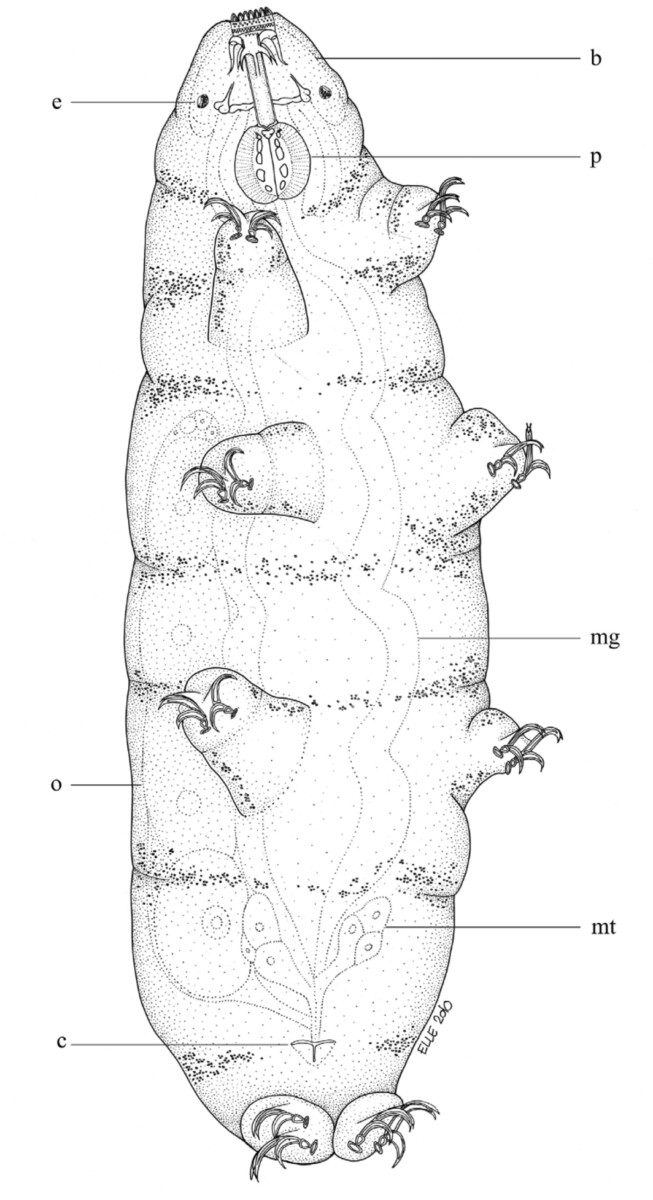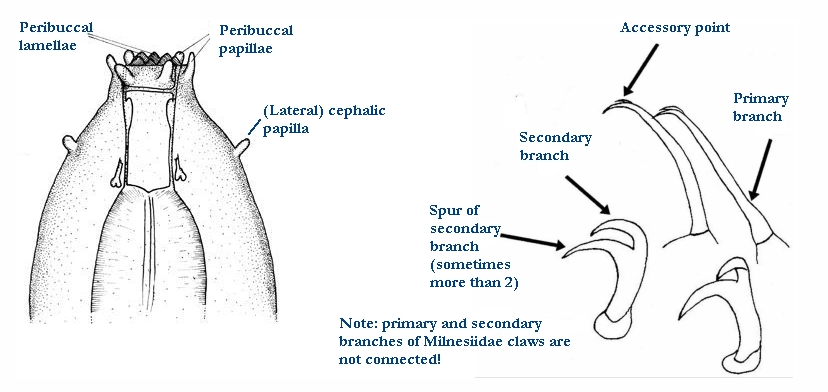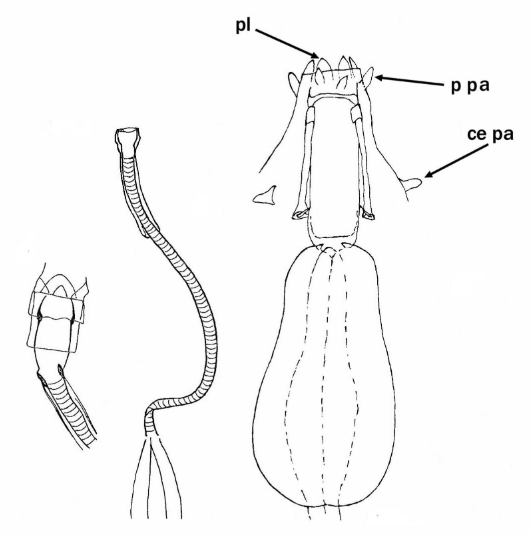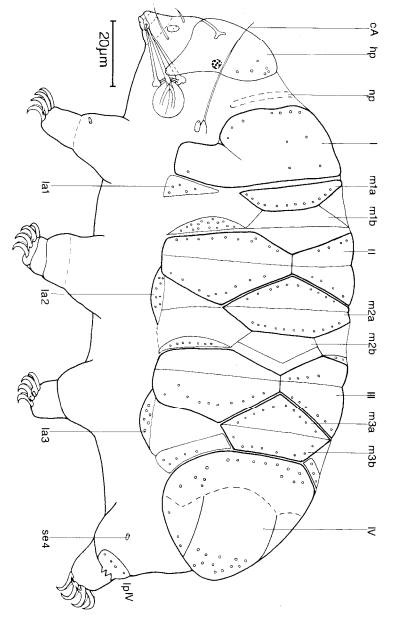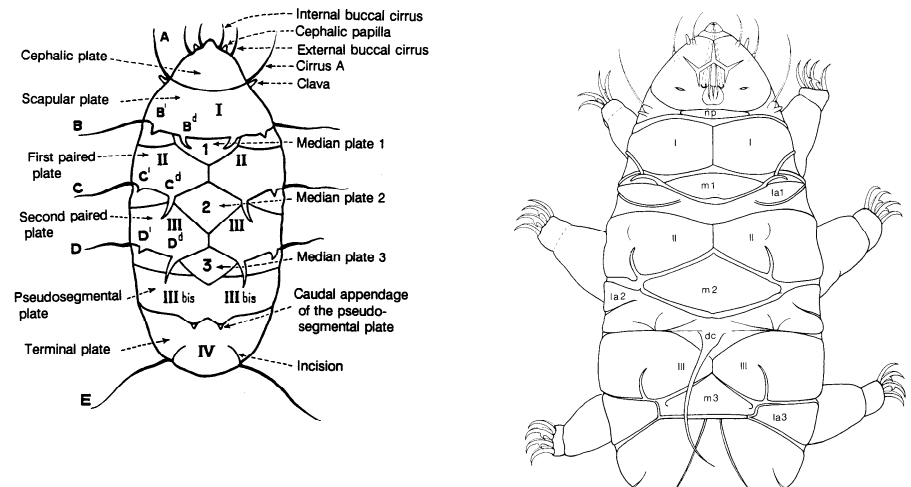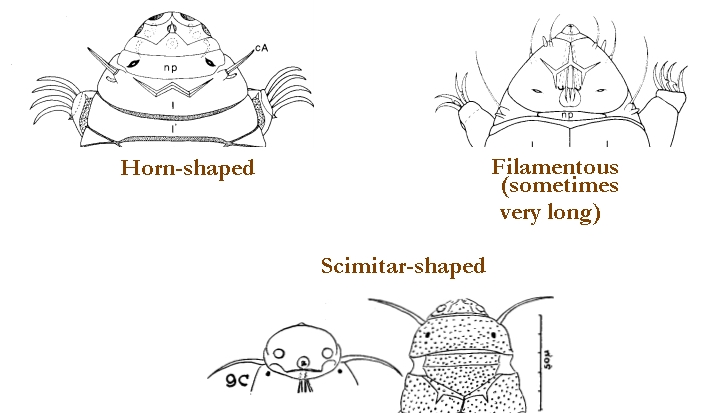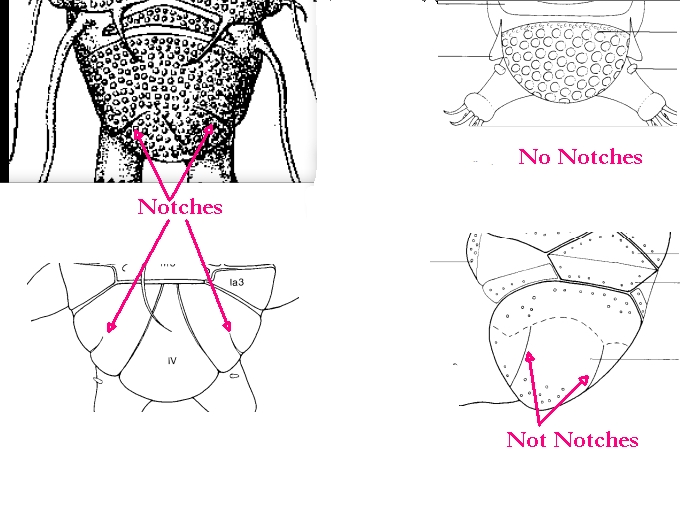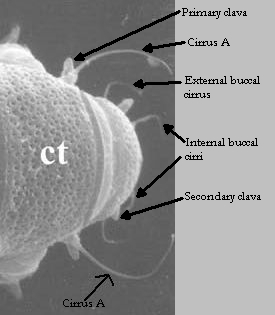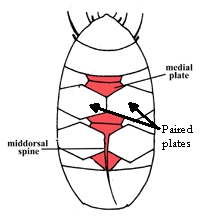Macrobiotoidea from Marley et al. 2011: “Parachela; claw pairs symmetrical (2112); AISM generally asymmetrical, due to the ventral lamina, with lateral caudal processes of crests and hooks.”
Macrobiotoidea from Bertolani et al. 2014: “Double claws symmetrical with respect to the median plane of the leg (sequence 2112); double claw of each leg similar in shape and size; each double claw characterized by the presence of a peculiar stalk (peduncle) with cylindrical or laminar shape; 10 peribuccal lamellae or papulae; buccal tube strengthened by a ventral lamina. Eggs laid freely and always surrounded by an ornamented shell.”
Macrobiotidae from Thulin 1928: “Fam. Macrobiotidae zeichnet sich dadurch aus, dass Sinnesanhänge am Kopfe fehlen. Die Krallen sind zweihakig. Die hintere an jeder Extremität kann mehr oder weniger vollständig in Basal- und Terminal-kralle aufgeteilt sein, die vordere ist dagegen niemals in dieser Weise differenziert. Die Länge und Weite der Mundröhre variiert erheblich innerhalb dieser Familie, ebenso die Form des Schlundkopfes. Die Mundöffnung ist nicht durch Klappen verschliessbar, aber bisweilen (bei vielen Macrobiotus-Arten) von einem Lamellenkranz umgeben. Die Stilette sind mehr oder weniger stark bogenförmig gekrümmt, mit der Konvexität des Bogens medialwärts gewendet, und kräftiger als bei den übrigen Tardigraden.”
Translation: Fam. Macrobiotidae is characterized by the fact that sensory appendages are missing on the head. The claws are double-hooked. The posterior of each claw may be more or less completely divided into basal and terminal [secondary] claws, whereas the anterior [primary branch] is never differentiated in this way. The length and width of the mouth tube varies considerably within this family, as does the shape of the pharynx. The mouth opening is not closed by flaps, but sometimes (in many Macrobiotus species) surrounded by a lamellae. The stylets are more or less curved, with the convexity of the arch turned towards the medial direction, and stronger than in other tardigrades.
Macrobiotidae from Guidetti et al. 2005: “Parachela with double-claws of each leg similar in shape and size and symmetrical with respect to the median plane of the leg (sequence 2112). Y-shaped claws, with claw branches fused over a tract of variable length (common tract). Ten peribuccal structures (lamellae or papulae) present. Epicuticular layer compact and uniform, without pillar-like structures.”
Macrobiotidae from Bertolani et al. 2014: “Double claws Y-shaped, with the two branches forming an evident common basal tract of variable length. Buccal tube completely rigid, or caudally annulated.”
Genus description from Guidetti et al. 2009: “Macrobiotids with Y-type claws, cuticle smooth and without pores; mouth ring with ten evident peribuccal lamellae; buccal armature showing ventrally and dorsally a posterior crown of strong triangular or bicuspidal teeth followed (at least dorsally) by three robust transverse crests; large buccal tube; three clearly rod shaped and elongated macroplacoids; microplacoid clearly distant (more than its length) from the third macroplacoid, or absent; eggs with large and reticulated (at light microscope) processes; very long and thin spermatozoa, with head longer than the tail.”
Genus description from Kaczmarek et al. 2017: “Most characters as described by Guidetti et al. 2009 and additionally: cuticular pores absent, oral cavity armature (OCA) of harmsworthi type (sensu Michalczyk and Kaczmarek 2003), almost always composed of three bands of teeth (except for three species in which the first band of teeth is not visible in LM or for P. ricthersi and P. areolatus in which the OCA is not known but probably present. Buccal tube with ventral lamina. Macroplacoid configuration: 2<1<3. Smooth lunules under claws present. Egg types: areolatus, beotiae, chiergoi, csotiensis, huziori, ricthersi, submoralatus and tonollii.”
Citations :
Left image modified from Tumaov DV. 2005. Notes on the Tardigrada of Thailand, with a description of Macrobiotus alekseevi sp. nov. (Eutardigrada, Macrobiotidae). Zootaxa 999: 1-16.
Right image modified from Pilato G. 2000. Macrobiotus centesimus, new species of eutardigrade from South America. Bollettino delle Sedute della Accademia Gioenia di Scienze Naturali in Catania. 33(358): 97-101.
Bertolani R, Guidetti R, Marchioro T, Altiero T, Rebecchi L, Cesari M. 2014. Phylogeny of Eutardigrada: New molecular data and their morphological support lead to the identification of new evolutionary lineages. Molecular Phylogenetics and Evolution. 76: 110-126.
Guidetti R, Gandolfi A, Rossi V, Bertolani R. 2005. Phylogenetic analysis of Macrobiotidae (Eutardigrada, Parachela): a combined morphological and molecular approach. Zoologica Scripta. 34 (3): 235-244.
Guidetti R, Schill RO, Bertolani R, Dandekar T, Wolf M. 2009. New molecular data for tardigrade phylogeny, with the erection of Paramacrobiotus gen. nov. Journal of Zoological Systematics and Evolutionary Research 47: 315-321.
Kaczmarek Ł, Gawlak M, Bartels PJ, Nelson DR, Roszkowska M. 2017. Revision of the genus Paramacrobiotus Guidetti et al., 2009 with the description of a new species, re-descriptions and a key. Annales Zoologici 67: 627-656.
Marley NJ, McInnes SJ, Sands CJ. 2011. Phylum Tardigrada: A re-evaluation of the Parachela. Zootaxa. 2819: 51-64.
Thulin G. 1928. Über die phylogenie und das system der tardigraden. Zoologisches Institut, Lund.
